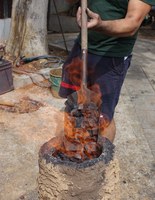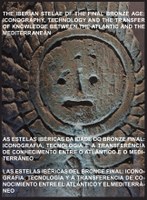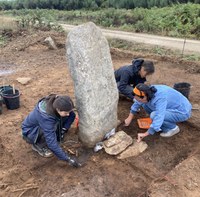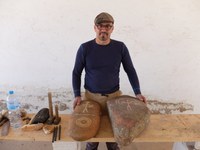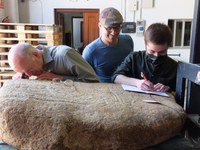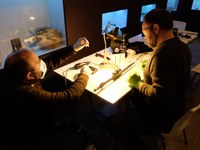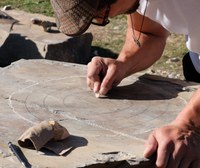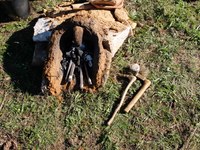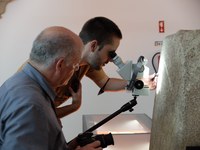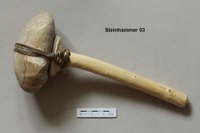Team / Equipa / Equipo
Project Contact:
Dr. Ralph Araque Gonzalez
Albert-Ludwigs-Universität Freiburg
Institut für Archäologische Wissenschaften (IAW), Abt. Urgeschichtliche Archäologie
Belfortstraße 22
D-79098 Freiburg
E-mail: ralph.araque.gonzalez@archaeologie.uni-freiburg.de
Phone: +49 (0)761 203 3388
Experiment Teilnehmer / Participants / Participantes:
Projektleiter des DFG-Projektes / Project coordinator of DFG project / Coordenador do projeto DFG "Die iberischen Stelen der Spätbronzezeit: Bildkunst, Technologie und Wissenstransfer zwischen Atlantik und Mittelmeer". Er koordiniert den Experimentablauf und dokumentiert die Ergebnisse / Coordinates the experiment and records the findings and results / Coordena a experiência e regista os achados e os resultados.
Publicações / Publikationen / Publications:
(Fotos: David Ferro and Ana Lages)
Jan Schnorrenberg
Steinmetzmeister aus Freiburg. In seiner Werkstatt entstand 2016 die Idee zum Projekt. Er hat unsere Granit-Probestele gepickt und die ersten Experimente mit Quarzithämmern durchgeführt. Jan unterstützt uns weiterhin mit technischem Support, für unsere Bedürfnisse angepasstem Werkzeug für die Kernbohrungen und Know-How.
Stonemason from Freiburg. The idea for this project originated in his workshop in 2016. He worked the first test-stele from granite with quartzite hammers. Jan is still helping us with technical support, customized tools for core-drilling and know-how.
Canteiro de Friburgo. A ideia deste projeto surgiu na sua oficina em 2016. Foi ele quem fez a primeira estela-teste a partir de granito com martelos de quartzito. Jan ainda nos ajuda com a assistência técnica, ferramentas específicas para perfuração de núcleos e conhecimento.
Maestro cantero de Friburgo, Alemania. La idea para este proyecto nació en su taller en 2016. Fue él quien hizo la primera estela de prueba picando el granito con martillos de cuarcita. Jan sigue ayudándonos con asistencia técnica, con herramientas específicas para la perforación de núcleos y sus conocimientos técnicos.
Contact: https://steinmetz-freiburg.de

(Foto: Gallo)
Giuseppe Vintrici
Steinmetz aus Freiburg. Er bearbeitet Stelen aus Granit, Grauwacke und Quarzit mit Repliken derjenigen Werkzeuge, die seinen Vorgängern in der Bronzezeit zur Verfügung standen.
Stonemason from Freiburg, working the stelae from granite, schist and quartzite with replications of the same tools available to his predecessors in the Bronze Age.
Canteiro de Friburgo, produz as estelas a partir do granito, xisto e quartzito, com réplicas das mesmas ferramentas disponíveis aos seus predecessores na Idade do Bronze.
Cantero de Friburgo, Alemania. Trabaja con estelas de granito, grauvaca y cuarcita utilizando réplicas de las mismas herramientas que empleaban sus predecesores en la Edad de Bronce.


(Fotos: David Ferro and Ralph Araque)
Dr. Bastian Asmus
Archäometallurge, Experimentalarchäologe und Bronzegießer. Er repliziert Bronzemeißel nach iberischen Originalvorbildern aus der Zeit um 1200-800 v. Chr. in damals gängigen Legierungen und beteiligt sich an den Materialanalysen der archäologischen Fundstücke.
Archaeometallurgist, Experimental Archaeologist and professional Bronze Caster. He replicates bronze chisels corresponding to the original models that have been used in Iberia between ca. 1200-800 BC with the according prehistoric alloys and analyses archaeological finds.
Especialista em Arqueometalurgia, Arqueologia Experimental e fundidor de bronze profissional. É ele quem analisa os achados arqueológicos com metalografia e faz também as réplicas dos cinzéis de bronze correspondentes aos modelos originais que foram usados na Península Ibérica entre ca.1200-800 a.C., com as ligas pré-históricas correspondentes.
Contact: https://archaeometallurgie.de


(Fotos: Pedro Baptista and David Ferro)
Alex Richter
Schmied in Sevilla, betreibt die Schmiede Fragua Fuirio. Er repliziert Eisenmeißel nach iberischen Originalvorbildern aus der Zeit um 900-800 v. Chr. mit damals gängigen Materialeigenschaften, experimentiert in zusammenarbeit mit Bastian Asmus mit prähistorischen Schmelzverfahren, baut mit Juan Monje Rennöfen nach uralter Methode, in denen eisenmineralien und -erze geschmolzen werden, und beteiligt sich an den Materialanalysen der Schlacken aus denSchmelzexperimenten.
Blacksmith in Seville, runs the Fragua Fuirio forge. He replicates iron chisels based on original Iberian models from the period around 900-800 BC with material properties common at the time, experiments with prehistoric smelting processes in collaboration with Bastian Asmus, builds bloomery/ renn furnaces with Juan Monje using ancient methods, in which iron minerals and ores are smelted, and participates in the material analyses of the slags from the smelting experiments.
Contact: http://fuirio.es/en/


(Fotos left: Ralph Araque / right: Roy Doberitz)
Juan Monje
Lehmbauer aus Sevilla. Er baut Rennöfen nach uralter Methode für unsere Experimente und hilft Alex bei allen handwerklichen Tätigkeiten, die im Zusammenhang mit dem Schmelzen stehen. Er steuert sein breites Wissen zu Lehmbau und Keramik bei.
Loam constructor and potter from Seville. He builds furnances and kilns according to ancient methods for our experiments and helps Alex with all craft activities related to fusing. He contributes with his broad knowledge of clay, loam construction and ceramics.
Contact: https://de-de.facebook.com/TallerelGremio.Sevilla/ and https://tierradelmonje.blogspot.com/2020/03/?m=0
(Foto: Ralph Araque)
Dr. Michael Kaiser
Experte für prähistorische Steinwerkzeuge und Experimentalarchäologe. Er repliziert Quarzit-Werkzeuge für die Gesteinsbearbeitung nach prähistorischen Originalvorbildern die teils schon seit dem Aufkommen von Homo sapiens benutzt wurden, berät den Steinmetz bei deren Handhabung und Wartung und nimmt Werkzeuganalysen vor.
Expert for prehistoric lithic tools and Experimental Archaeologist. He replicates lithic tools for stone working corresponding to the original prehistoric models that have been used sometimes as long as homo sapiens exists, instructs the stonemason in their possible uses and analyses archaeological finds.
Especialista em ferramentas líticas pré-históricas e em Arqueologia Experimental. É o responsável pelas réplicas das ferramentas líticas para o trabalho da pedra, correspondentes aos modelos originais pré-históricos que têm sido usados por vezes desde que o Homo Sapiens existe. Dá instruções ao canteiro sobre os seus possíveis usos e analisa achados arqueológicos.
Experto en herramientas prehistóricas de piedra y Arqueología Experimental. Fabrica réplicas de herramientas de cuarcita para el trabajo de la piedra según modelos prehistóricos originales, algunos de los cuales se han utilizado desde que existe el homo sapiens; además asesora al cantero en su manejo y mantenimiento, y realiza análisis de herramientas.
Contact: michjkaiser@web.de
https://independent.academia.edu/KaiserMichael


(Fotos: Ralph Araque and Giuseppe Vintrici)
Prof. Dr. Rafael Ferreiro Mählmann
Professor für Petrologie am Institut für angewandte Geowissenschaften der TU Darmstadt. Er bestimmt die Gesteinstypen, welche für die Stelen verwendet wurden und analysiert die Fundstücke sowie die Gesteinsvorkommen in Portugal. Damit können nicht nur die physikalischen Eigenschaften der Gesteine erschlossen werden, es wird auch zeigen, ob sie über weitere Strecken transportiert wurden, um Stelen zu errichten.
Professor for Petrology at the institute of Applied Geoscience at the TU Darmstadt. He classifies the rock types that had been used for the stelae and analyses the archaeological finds as well as the surrounding outcrops in Portugal. Thereby we can not only define the physical properties of the rocks, but it will also be determined whether some have been transported over significant distances.
Professor de Petrologia no Instituto de Geosciencía Applicada da Universidade Técnica de Darmstadt. Classifica os tipos de rocha que foram usados nas estelas e analisa os achados arqueológicos assim como os afloramentos em Portugal. Neste sentido, será não só possível definir as propriedades físicas das pedras, mas também será determinado se algumas terão sido transportadas ao longo de distâncias significativas.
Catedrático de Petrología en el Instituto de Geociencias Aplicadas de la Universidad Técnica (TU) de Darmstadt. Clasifica los tipos de roca utilizados en las estelas y analiza los hallazgos arqueológicos, así como los afloramientos líticos en Portugal. Su trabajo no solo permite revelar las propiedades físicas de las rocas, sino que también contribuye a determinar si algunas fueron transportadas a largas distancias para erigir estelas.


(Fotos: Ralph Araque)
Pedro Baptista M.A.
Doktorand an der Uni Coimbra und Mitarbeiter im Projekt an der Uni Freiburg. Sein Spezialgebiet ist die Landschaftsarchäologie, er beteiligt sich beim Experiment und ist Rafael Ferreiro Mählmanns unentbehrlicher Assitent bei der mesoskopischen Gesteinsaufnahme.
Doctoral researcher at the University of Coimbra and in this project at the University of Freiburg. His scientific focus is landscape archaeology, he participates in the experiment and is Rafael Ferreiro's indispensable assistant for the mesoscopic analysis of the rocks.
Doctorando de la Universidad de Coimbra y colaborador en el proyecto de la Universidad de Friburgo. Especialista en arqueología del paisaje, participó en el experimento y ha sido el asistente insustituible de Rafael Ferreiro Mählmann en el análisis mesoscópico de las rocas.
Contact: pedro-esb@hotmail.com
Publicações / Publikationen / Publications:


(Fotos: Ana Lages and Ralph Araque)
Hospitality and Support in Baraçal and Sabugal: The Local Team in Portugal
Very special thanks for the best support in all situations and for showing us again and again what the Portuguese "desenrascar" means go out Marcos Osório, Vítor Clamote, Paulo Pernadas and the team from the Museu do Sabugal, Carlos Borregana, mayor of Baraçal and his wife Ana Lages as well as our incredible hosts Alvaro and Sylvie Janelas, who offered us their amazing hospitality. Special thanks to David Ferro for filming a short documentary about our experiment!
Um agradecimento muito especial pelo excelente apoio prestado em todas as situações e por nos mostrarem uma e outra vez o que significa o “desenrascanço” Português, ao Marcos Osório, Vítor Clamote, Paulo Pernadas e à equipa do Museu do Sabugal, ao Carlos Borregada, Presidente da Junta de Freguesia do Baraçal, e à sua esposa Ana Lages, assim como aos nossos incríveis anfitriões Alvaro e Sylvie Janelas, que nos ofereceram a sua incrível hospitalidade. Special thanks a David Ferro para filmar un documental da nossa experiencia!
Un agradecimiento muy especial por su inestimable apoyo en todas las situaciones y por habernos enseñado una y otra vez lo que significa improvisar en Portugal, para Marcos Osório, Vítor Clamote, Paulo Pernadas y el equipo del museo de Sabugal, el alcalde de Baraçal, Carlos Borregana y su esposa Ana Lages, así como a nuestros increíbles anfitriones Alvaro y Sylvie Janelas, por su gran hospitalidad. Gracias también a David Ferro por filmar un documental sobre nuestro experimento.
Ganz besonderer Dank für die tatkräftige Unterstützung in allen Angelegenheiten und dafür, uns immer wieder zu zeigen, was das Portugiesische "desenrascar" bedeutet, geht an Marcos Osório, Vítor Clamote, Paulo Pernadas und das Team vom Museum Sabugal, den Bürgermeister von Baraçal, Carlos Borregana und seine Frau Ana Lages sowie unseren großartigen Gastgebern Alvaro und Sylvie Janelas, die uns unglaublich herzliche Gastfreundschaft boten. Special thanks an David Ferro, der eine kurze Doku über unser Experiment gedreht hat!

(Foto: Ralph Araque)
Da esquerda, atrás da estela de Foiós, Giuseppe e a equipa do Museu do Sabugal, David Ferro (fotógrafo/cineasta), Marcos Osório (Diretor do Museu e arqueólogo), Vítor Clamote (geógrafo) e Ana Lages da Junta de Freguesia do Baraçal.
From left, Giuseppe and the team from the Museu do Sabugal, David Ferro (photographer/filmmaker), Marcos Osório (head of Museum and archaeologist), Vítor Clamote (geographer) and Ana Lages from the Ayuntamiento do Baraçal, all behind the stela of Foiós.
Von links, Giuseppe und das Team vom Museum Sabugal, David Ferro (Fotograf und Filmer) Marcos Osório (Museumsleiter und Archäologe), Vítor Clamote (Geograf) sowie Ana Lages von der Ortsverwaltung Baraçal, alle hinter der Stele von Foiós.


(Fotos: Ralph Araque)
À esquerda, Carlos Borregana, Presidente da Junta de Freguesia do Baraçal, na sua escavadora ajuda na relocação da rocha. À direita, Alvaro e Sylvie Janelas. Alvaro esteve presente quando a estela do Baraçal 2 foi encontrada no decorrer da renovação da casa da sua irmã, onde a estela, virada ao contrário, tinha anteriormente servido como banco e bancada de trabalho.
To the left Carlos Borregana, mayor of Baraçal in his excavator helping to relocate our rock, to the right Alvaro and Sylvie Janelas. Alvaro was present when the stela of Baraçal 2 was found while renovating the house of his sister, where the stela was formerly used face down as a seat and work-bench.
Links Carlos Borregana, Bürgermeister von Baraçal, in seinem Bagger beim Versetzen unserers Steines, rechts Alvaro und Sylvie Janelas. Alvaro war dabei, als die Stele von Baraçal 2 beim Renovieren des Hauses seiner Schwester gefunden wurde, wo sie mit der dekorierten Seite nach unten als Sitz- und Werkbank gedient hatte.
Hospitality and Support in Valverde de Burguillos: The Local Team in Extremadura
Very special thanks for their amazing support for our second experiment in Valverde de Burguillos goes out to the people and Alcaldia of Valverde! thanks to Carlos, the alcalde, for letting us stay in their brandnew Albergue for researchers, with which the community is greatly facilitating any kind of reserach conducted in the area. Gracias!!
Very special thanks also to Dr. Pablo Paniego Díaz for his continuous support, for bringing Valverde and us together, and for help and logistics as well as scientific consultancy during our stay and beyond!
Gastfreundschaft und Unterstützung in Valverde de Burguillos: Das lokale Team in der Extremadura
Ganz besonderer Dank für die großartige Unterstützung unseres zweiten Experiments in Valverde de Burguillos geht an die Menschen und die Alcaldia von Valverde! Wir danken Carlos, dem Alcalde, dafür, dass er uns in seiner nagelneuen Albergue für Forscher untergebracht hat, womit die Gemeinde jede Art von Forschung in der Gegend erheblich erleichtert. Gracias!!
Ganz besonderer Dank geht auch an Dr. Pablo Paniego Díaz für seine kontinuierliche Kooperation im Projekt und dafür, dass er Valverde und uns zusammengebracht hat, sowie für die Hilfe bei Logistik und die wissenschaftliche Zusammenarbeit während unseres Aufenthalts und darüber hinaus!
(Foto: Roy Doberitz)
From left to right: Iratxe Boneta Jiménez, Pablo Paniego Díaz, Pepe Vintrici, Ralph Araque, Alex Richter, Carlos Delgado Méndez, Juan Monje, Roy Doberitz.
Translations / Traduçãoes / Traducciónes / Übersetzungen
Ana Amor Santos (Coimbra) - English, Portugues Contact: https://praeteritumtraduz.wixsite.com/passado/en
Rocío Bargon Sánchez (Freiburg) - Deutsch, Español, Portugues
Javier Yepes (Huelva) - English, Español
Database / Base de Dados / Datenbank
Vera Rammelkammer (Freiburg)
Technical Support
Michael Kinsky, Freiburg
Supplementary Photographs and Filming / Ergänzende Fotos und Filmmaterial
Roy Doberitz (Freiburg)




